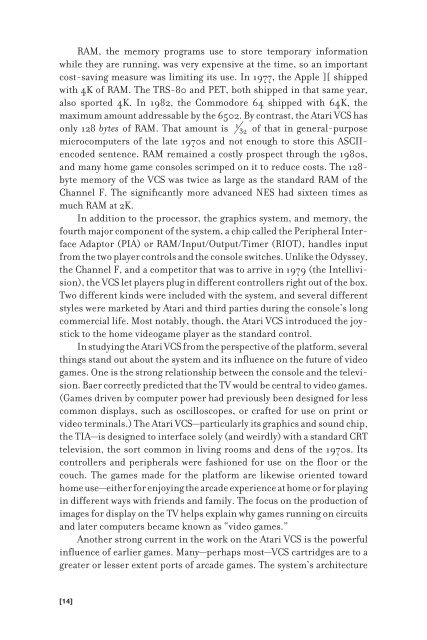Racing the Beam : the Atari Video Computer System - Index of
Racing the Beam : the Atari Video Computer System - Index of
Racing the Beam : the Atari Video Computer System - Index of
You also want an ePaper? Increase the reach of your titles
YUMPU automatically turns print PDFs into web optimized ePapers that Google loves.
RAM, <strong>the</strong> memory programs use to store temporary information<br />
while <strong>the</strong>y are running, was very expensive at <strong>the</strong> time, so an important<br />
cost-saving measure was limiting its use. In 1977, <strong>the</strong> Apple ][ shipped<br />
with 4K <strong>of</strong> RAM. The TRS-80 and PET, both shipped in that same year,<br />
also sported 4K. In 1982, <strong>the</strong> Commodore 64 shipped with 64K, <strong>the</strong><br />
maximum amount addressable by <strong>the</strong> 6502. By contrast, <strong>the</strong> <strong>Atari</strong> VCS has<br />
only 128 bytes <strong>of</strong> RAM. That amount is 1 32 <strong>of</strong> that in general-purpose<br />
microcomputers <strong>of</strong> <strong>the</strong> late 1970s and not enough to store this ASCIIencoded<br />
sentence. RAM remained a costly prospect through <strong>the</strong> 1980s,<br />
and many home game consoles scrimped on it to reduce costs. The 128byte<br />
memory <strong>of</strong> <strong>the</strong> VCS was twice as large as <strong>the</strong> standard RAM <strong>of</strong> <strong>the</strong><br />
Channel F. The signifi cantly more advanced NES had sixteen times as<br />
much RAM at 2K.<br />
In addition to <strong>the</strong> processor, <strong>the</strong> graphics system, and memory, <strong>the</strong><br />
fourth major component <strong>of</strong> <strong>the</strong> system, a chip called <strong>the</strong> Peripheral Interface<br />
Adaptor (PIA) or RAM/Input/Output/Timer (RIOT), handles input<br />
from <strong>the</strong> two player controls and <strong>the</strong> console switches. Unlike <strong>the</strong> Odyssey,<br />
<strong>the</strong> Channel F, and a competitor that was to arrive in 1979 (<strong>the</strong> Intellivision),<br />
<strong>the</strong> VCS let players plug in different controllers right out <strong>of</strong> <strong>the</strong> box.<br />
Two different kinds were included with <strong>the</strong> system, and several different<br />
styles were marketed by <strong>Atari</strong> and third parties during <strong>the</strong> console’s long<br />
commercial life. Most notably, though, <strong>the</strong> <strong>Atari</strong> VCS introduced <strong>the</strong> joystick<br />
to <strong>the</strong> home videogame player as <strong>the</strong> standard control.<br />
In studying <strong>the</strong> <strong>Atari</strong> VCS from <strong>the</strong> perspective <strong>of</strong> <strong>the</strong> platform, several<br />
things stand out about <strong>the</strong> system and its infl uence on <strong>the</strong> future <strong>of</strong> video<br />
games. One is <strong>the</strong> strong relationship between <strong>the</strong> console and <strong>the</strong> television.<br />
Baer correctly predicted that <strong>the</strong> TV would be central to video games.<br />
(Games driven by computer power had previously been designed for less<br />
common displays, such as oscilloscopes, or crafted for use on print or<br />
video terminals.) The <strong>Atari</strong> VCS—particularly its graphics and sound chip,<br />
<strong>the</strong> TIA—is designed to interface solely (and weirdly) with a standard CRT<br />
television, <strong>the</strong> sort common in living rooms and dens <strong>of</strong> <strong>the</strong> 1970s. Its<br />
controllers and peripherals were fashioned for use on <strong>the</strong> fl oor or <strong>the</strong><br />
couch. The games made for <strong>the</strong> platform are likewise oriented toward<br />
home use—ei<strong>the</strong>r for enjoying <strong>the</strong> arcade experience at home or for playing<br />
in different ways with friends and family. The focus on <strong>the</strong> production <strong>of</strong><br />
images for display on <strong>the</strong> TV helps explain why games running on circuits<br />
and later computers became known as “video games.”<br />
Ano<strong>the</strong>r strong current in <strong>the</strong> work on <strong>the</strong> <strong>Atari</strong> VCS is <strong>the</strong> powerful<br />
infl uence <strong>of</strong> earlier games. Many—perhaps most—VCS cartridges are to a<br />
greater or lesser extent ports <strong>of</strong> arcade games. The system’s architecture<br />
[14]


